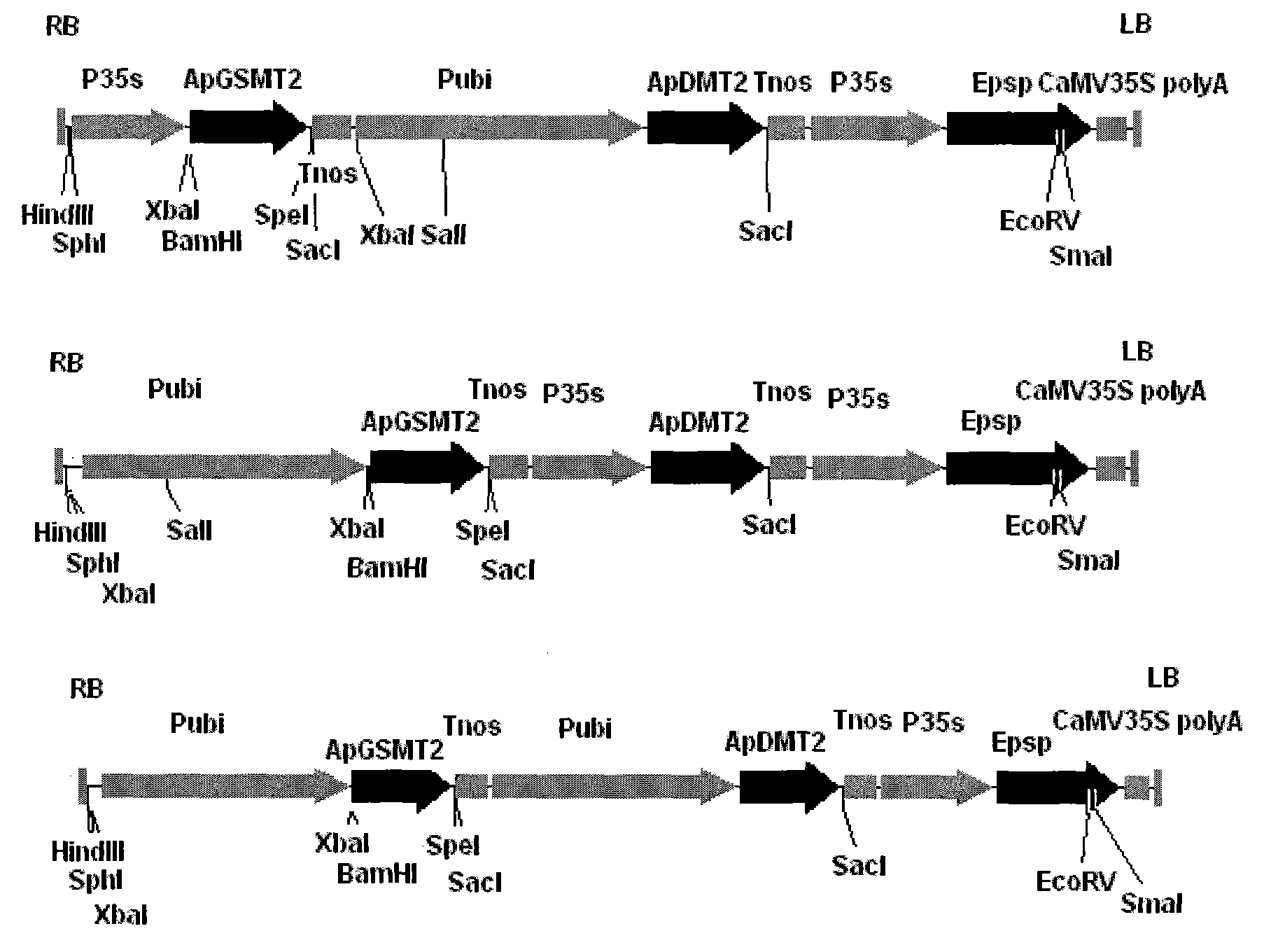Methyl transferase gene in betaine synthesis path and modification and application thereof
A technology of methyltransferase and synthetic pathway, applied in genetic engineering, plant genetic improvement, application, etc., can solve the problem of unreported betaine accumulation level, etc.
- Summary
- Abstract
- Description
- Claims
- Application Information
AI Technical Summary
Problems solved by technology
Method used
Image
Examples
Embodiment 1
[0087] Example 1: ApGSMT2 / ApDMT2 gene cloning and creation of maize transgenic stress-resistant materials
[0088] 1) ApGSMT2 / ApDMT2 gene cloning
[0089] Cultivate Aphanothece halophytica to OD600=1.2, take 30ml of the bacterial liquid into a 50ml centrifuge tube, and collect the bacterial cells by centrifugation. The cells were resuspended in STE (0.1M NaCl, 10mM Tris-HCl (pH 8.0), 1mM EDTA (pH 8.0)), collected by centrifugation, and repeated once. Then add 20ml 2×CTAB (100mmol / LTris-HCl pH 8.0, 1.4mol / LNaCl, 20mmol / LEDTA pH 8.0, 2% CTAB) buffer, mix well, and incubate in a water bath at 65°C for 90min (add 1%β before preheating -mercaptoethanol), shake well 2-3 times in between. Then the centrifuge tube was taken out from the water bath, after cooling to room temperature, an equal volume of chloroform / isoamyl alcohol (24:1) was added, the centrifuge tube was gently inverted several times, and centrifuged at 10,000 rpm for 10 min at room temperature. Then transfer the sup...
Embodiment 2
[0112] Example 2: Synthesis of ApGSMT2d and ApDMT2d genes and creation of maize transgenic stress-resistant materials
[0113] 1) Synthesis of ApGSMT2d and ApDMT2d genes and construction of plant expression constructs
[0114] ApGSMT2d and ApDMT2d genes were artificially synthesized by substituting partial codons of ApGSMT2 and ApDMT2 with preferred codons of cereals and maize. Then it was connected with the RD29 promoter to construct the fusion gene, and the latter was recombined into the plant expression vector pCPE to generate pCPE-ApGSMT2d-ApDMT2d. Introduction of recombinant plasmids into Agrobacterium tumefaciens for genetic transformation.
[0115] 2) Obtaining sterile corn seedlings
[0116] Bagging to obtain the seeds of corn backbone inbred lines such as Zheng 58, Qi 319, Chang 7-2, etc., soaked with 70% ethanol for 10 minutes, then soaked with 0.1% mercuric chloride for 10-12 minutes, and then washed with sterile water for 3 -5 times. Shake the seeds constantly ...
Embodiment 3
[0132] Example 3, construction of ApTpGSMT2d, ApTpDMTd2 genes and creation of maize transgenic stress-resistant materials
[0133] 1) Synthesis of ApTpGSMT2d and ApTpDMTd2 genes and construction of plant expression constructs
[0134] In order to efficiently express ApGSMT2 and ApDMT2 in maize cells and realize the accumulation of glycine betaine in chloroplasts (plastids), the ApGSMT2d and ApDMT2d genes were respectively fused with the coding region of the transit peptide for positioning chloroplast proteins, so that ApGSMT2 and ApDMT2 proteins are localized in chloroplasts (plastids) after synthesis, and catalyze the synthesis of a large amount of glycine betaine in chloroplasts. PCR primers were designed based on the reported Arabidopsis thaliana RUBISCO small subunit gene sequence, and the guide peptide coding region of the RUBISCO small subunit was cloned from Arabidopsis thaliana, and connected to the open reading frames of the ApGSMT2d gene and ApDMT2d gene after sequen...
PUM
 Login to View More
Login to View More Abstract
Description
Claims
Application Information
 Login to View More
Login to View More - R&D
- Intellectual Property
- Life Sciences
- Materials
- Tech Scout
- Unparalleled Data Quality
- Higher Quality Content
- 60% Fewer Hallucinations
Browse by: Latest US Patents, China's latest patents, Technical Efficacy Thesaurus, Application Domain, Technology Topic, Popular Technical Reports.
© 2025 PatSnap. All rights reserved.Legal|Privacy policy|Modern Slavery Act Transparency Statement|Sitemap|About US| Contact US: help@patsnap.com


